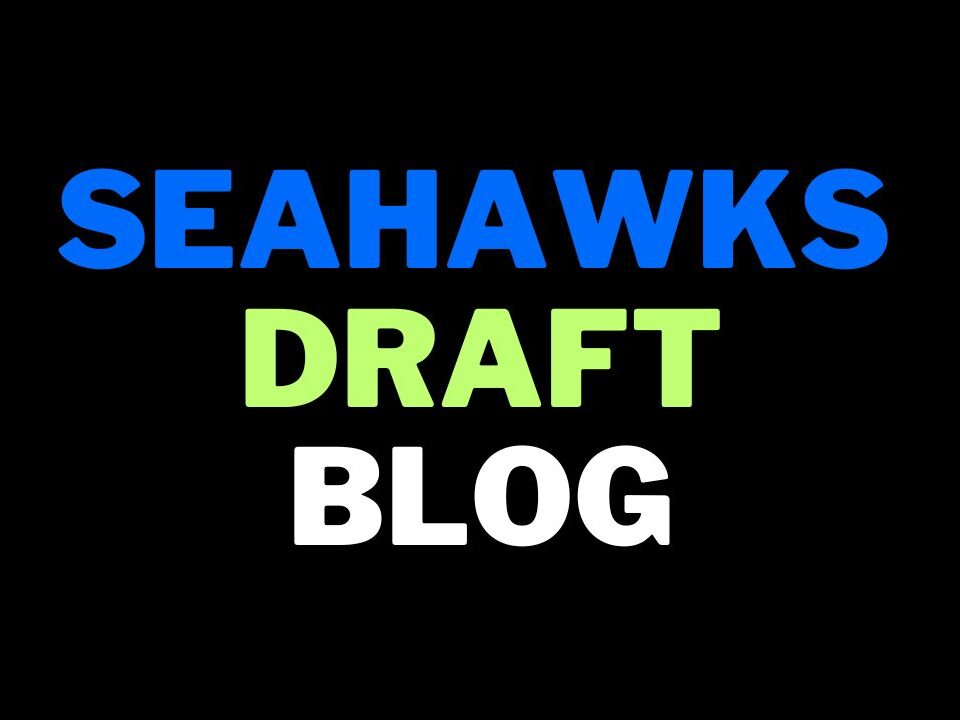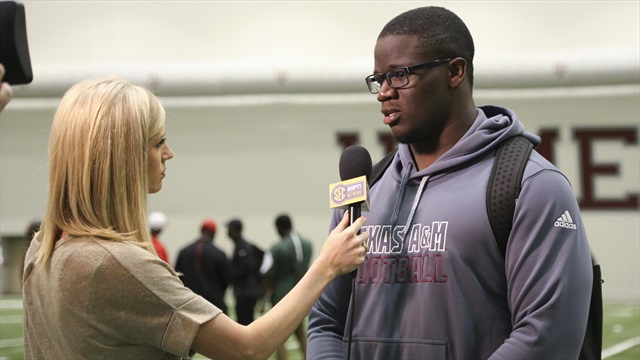
Are the Seahawks really letting Tom Cable pick his guys? Or are they looking for explosive athletes to combat the likes of Aaron Donald?
The Seahawks drafted three offensive linemen last year — Terry Poole, Mark Glowinski and Kristjan Sokoli. All three players passed had:
— At least a 9″ broad jump
— A cumulative score in TEF that matches Seattle’s ideal physical profile (31 inch vert, 9″ broad, 27 bench reps)
If you missed it here’s an explanation of what TEF (Trench Explosion Formula) is and why it matters.
Here’s every offensive lineman drafted in 2015 along with their TEF scores:
(ID = insufficient data to calculate)
Brandon Scherff — 2.90
Ereck Flowers — 3.07
Andrus Peat — ID
Cedric Ogbuehi — ID
Laken Tomlinson — 2.95
Donovan Smith — 3.02
Mitch Morse — 3.45
Jake Fisher — ID
Rob Havenstein — 2.34
Ty Sambrailo — 2.52
Ali Marpet — 3.09
Jeremiah Poutasi — 2.49
A.J. Cann — 3.19
Hroniss Grasu — ID
Jamon Brown — ID
John Miller — 2.91
Chaz Green — 2.67
Daryl Williams — 2.56
T.J. Clemmings — 2.95
Tre Jackson — 2.23
Arie Kouandjio — ID
Jamil Douglas — 2.76
Andrew Donnal — 2.71
Jon Feliciano — 2.43
Terry Poole — 3.12
Shaq Mason — 3.02
Max Garcia — 2.89
Mark Glowinski — 3.34
Jarvis Harrison — 2.77
Robert Myers — ID
Tayo Fabuluje — 2.29
Tyrus Thompson — 2.74
Ian Silberman — 2.94
Andy Galik — 2.62
Kristjan Sokoli — 3.75
Cody Wichmann — 2.55
Anthony Morris — 2.88
Austin Reiter — ID
Jake Rodgers — 2.81
Bobby Hart — 2.36
Austin Shepherd — 2.25
Corey Robinson — 3.04
Laurence Gibson — 3.16
Trenton Brown — 2.23
Denzelle Good — 2.76
Of the 45 drafted offensive linemen, only 11 scored a +3.00 using TEF. Ereck Flowers, Donovan Smith, Mitch Morse and Ali Marpet were all off the board before Seattle’s first pick — leaving only seven available to the Seahawks.
Pete Carroll and John Schneider have not drafted a single offensive lineman with sub-33 inch arms since 2010. That would also rule out A.J. Cann and Shaq Mason — meaning five TEF qualified linemen available.
Of that five, the Seahawks drafted three:
R4 Terry Poole
R4 Mark Glowinski
R6 Kristjan Sokoli
R7 Corey Robinson
R7 Laurence Gibson
Considering the arm length issue with Cann and Mason, the Seahawks didn’t actually pass on ANY TEF qualified lineman between Ali Marpet leaving the board and Terry Poole being selected. In fact after Marpet’s selection before Seattle’s second round pick, they proceeded to draft the next three TEF qualifiers to leave the board.
It looks like a calculated decision, just like the selection of Justin Britt in 2014 (explained here).
The evidence continues to stack up in support of the formula. This front office appears to be narrowing it’s search to the most explosive offensive linemen in each draft and picking from a select pool of players.
Here’s a quick review of the evidence we’ve found in the last week:
— Since 2012 they’ve only drafted players that fit the criteria we’ve identified in terms of TEF and the broad jump
— In 2014 Justin Britt was the last TEF qualified lineman in the draft available before Garrett Scott in round six — explaining why Seattle took Britt when they did and then added Scott later
— In 2015 they drafted three of five players that beat the TEF test
— Of this years combine group, the following five players in the 2016 draft are ‘TEF enough’: Jason Spriggs, Connor McGovern, Alex Redmond, Joe Haeg, Joe Dahl
— Brian Bobek (3.39) and Vi Teofilo (3.84) are two non-combine invitees that fit the TEF criteria. Anthony Fabiano scored a 2.98. Bobek probably has sub-33 inch arms given his smaller frame. Teofilo definitely misses out on arm length (30 3/4 inch arms).
I suspect the Seahawks use a more sophisticated albeit similar formula. I’m not convinced Laken Tomlinson’s 2.95 would’ve ruled him out considering he jumped a 9-0 in the broad and had the size/length they like. By the same token, I think Germain Ifedi’s 2.95 puts him in contention this year.
John Schneider admitted after the 2015 draft they got all the players ‘they had to have’ apart from one. It’s a safe prediction that this was Mitch Morse. His 3.45 TEF score was by far the highest in the O-line class and would’ve been an ideal replacement for Max Unger at center. Seattle’s fumbled approach to the position last season was possibly a direct impact of missing out on Morse — who they maybe expected to last until the late second round.
That said, the purpose of TEF is not to identify the most explosive/athletic offensive linemen and assume the Seahawks will draft them. It’s more about eliminating those who don’t meet the criteria and focusing on those who do.
For example, Jason Spriggs is clearly the best TEF lineman in the 2016 draft with a 3.54. That said, they might be more inclined to target Connor McGovern (3.29), Joe Haeg (3.06) or Joe Dahl (3.05) with a later pick. Likewise they might think Ifedi’s 2.95 is freaky enough for a 6-6, 324lbs lineman with 36 inch arms.
We’ll find out in less than three weeks whether we are truly onto something with TEF. If their draft habits continue as they have since 2012 — it probably won’t be a coincidence.
It could also prove that actually it’s not ‘Tom Cable picking his guys’ in Seattle. It’s the Seahawks working to a coordinated plan to find explosive offensive linemen to combat the growing disparity between college O-lines and D-lines.
Is center an outlier?
I’ve been asked a few times if the center position is relevant for TEF considering the decent number of ‘mediocre’ athletes playing the position effectively in the NFL.
I think if anything, TEF might be even more important at center in the modern NFL.
Kristjan Sokoli scored a 3.75 before the 2015 draft. That legitimately makes him a generational athlete entering the league. The Seahawks not only converted him from defense to offense — they strictly placed him at center.
When asked about Sokoli in his final press conference of the 2015 season, Pete Carroll stated it was their intention to keep him at center and give him more time to learn the position. He called Sokoli an “exceptional athlete”, adding if he can make it work they’ll have “one of the really good athletes at center”.
It’s pretty obvious why they are interested in this kind of move. Aaron Donald scores a 3.63 in TEF. Geno Atkins is a 3.65. Sheldon Rankins is a 3.52. Ndamukong Suh is a 3.28.
This is the type of player you’re facing in the NFL these days.
Seattle’s plan to try and create a 3.75 counter punch is, quite frankly, brave and brilliant. If it comes off they will be visionaries (again). While some in the league hope tough, hard-nosed and overmatched players can handle the Donald’s, Atkins’, Suh’s and Rankins’ — the Seahawks have what appears to be a much better plan.
Fight fire with fire.
Mitch Morse as a 3.45 TEF star would’ve been ideal and it goes to show that not only the Seahawks are conscious of the changing face of the NFL. The Chiefs knew what they were doing.
Connor McGovern (3.29) can play guard or center and, if drafted, could compete at both positions in camp.
The argument for going O-line at #26 over defense
When you put the entire 2016 class of defensive linemen through TEF, there are 27 players who pass the test compared to six offensive linemen.
While there are plenty of reasons to argue for Jonathan Bullard in round one — and it’d be a strong case — he is comparatively explosive to Vernon Butler, Hassan Ridgeway, Matt Ioannidis, Willie Henry and Anthony Zettel. Other prospects like Joel Heath, Charles Tapper, Ronald Blair III, Javon Hargrave and Yannick Ngakoue actually tested significantly better.
The pool of explosive defensive linemen to pick from is substantially greater than the O-liners. In turn, if you don’t take an offensive lineman at #26 — you run the risk of missing out because there’s no guarantee McGovern, Dahl and Haeg are going to last deep into rounds two and three.
Hatching a plan
In 2014 the Seahawks likely didn’t take Joel Bitonio because his explosive grade (3.03) was similar to Justin Britt’s (3.00). Taking Bitonio at #32 would’ve prevented them getting the receiver they wanted (Paul Richardson, who clearly fits their profile at wide out). Whether you agree with the plan or not — the Seahawks made sure they drafted two players they felt really comfortable with instead of one.
In 2016 — they likewise will concoct a plan to get two players they really like in rounds 1-2 instead of one. So while the players they actually select might confuse and befuddle fans and the media — we know better than to react like that.
The ideal pick?
It’s arguably Sheldon Rankins. He is, without doubt, the most explosive defensive player in the class with an incredible 3.52 TEF score at 300lbs. He has the physical profile to be as good as any defensive tackle in the NFL. He’s also very capable of playing D-end and wouldn’t need to come off the field at any point.
Unfortunately he’s highly unlikely to last until pick #26 and should be a top-15 pick. Assuming he’s gone, O-line at #26 looks the most likely option.







